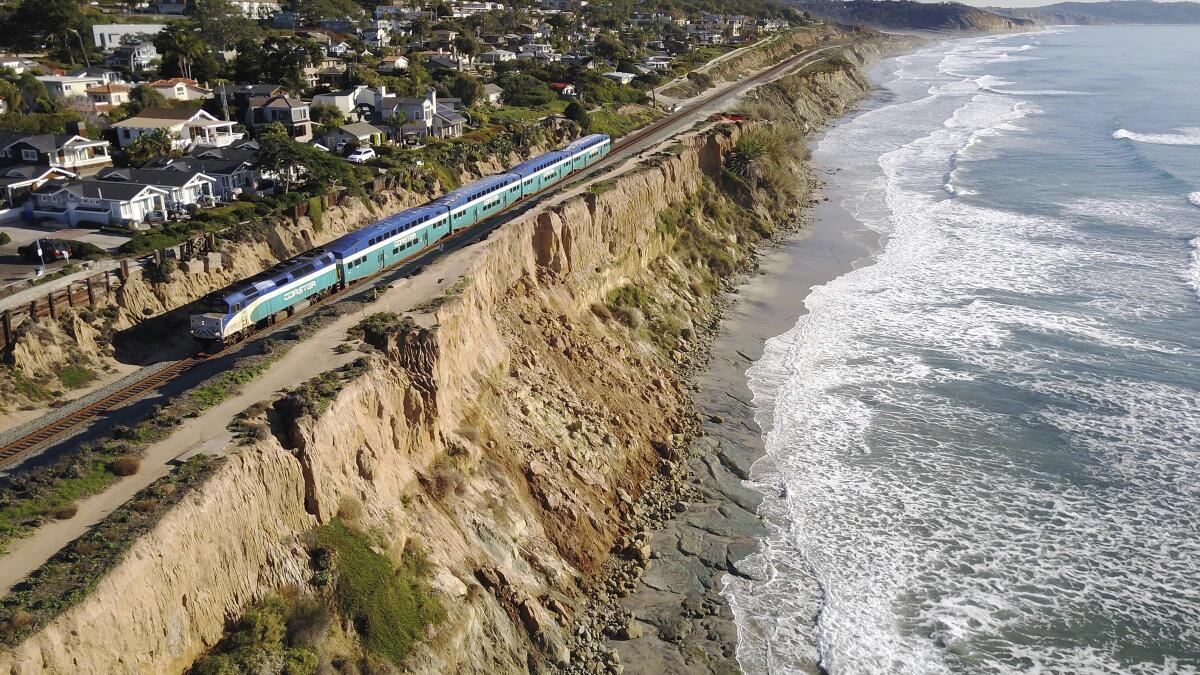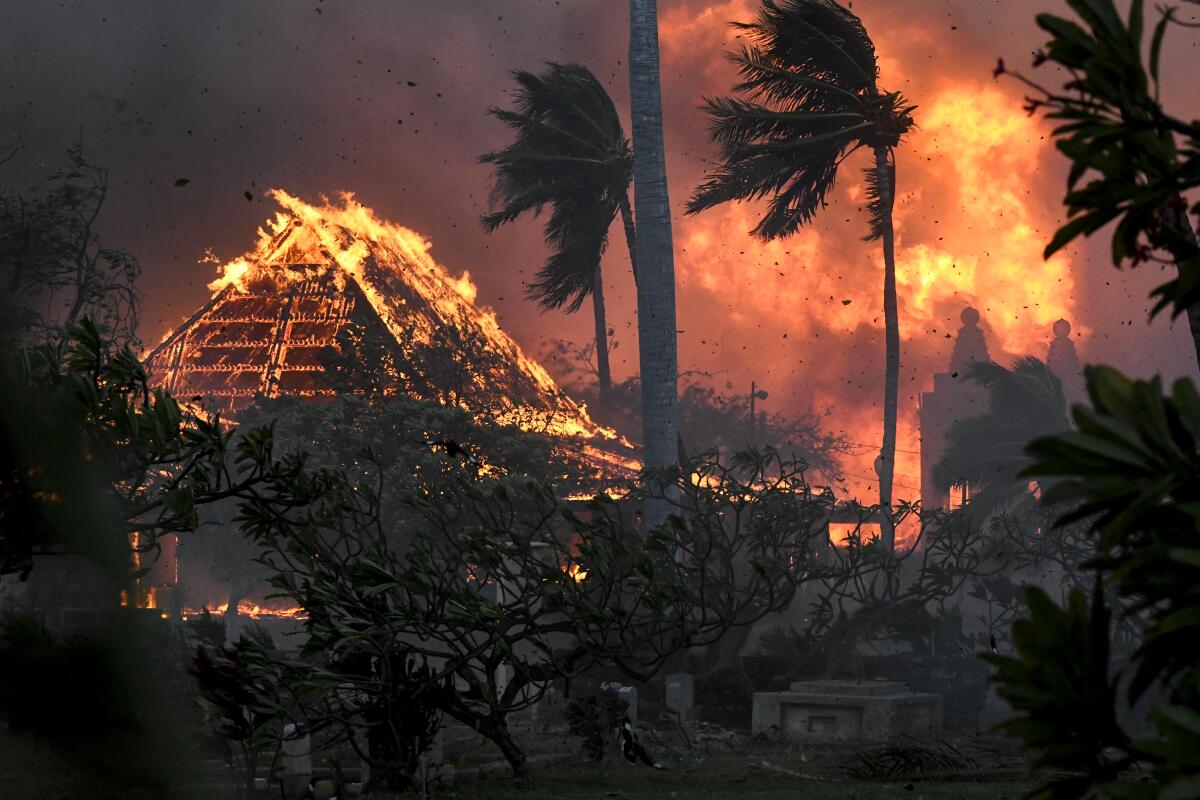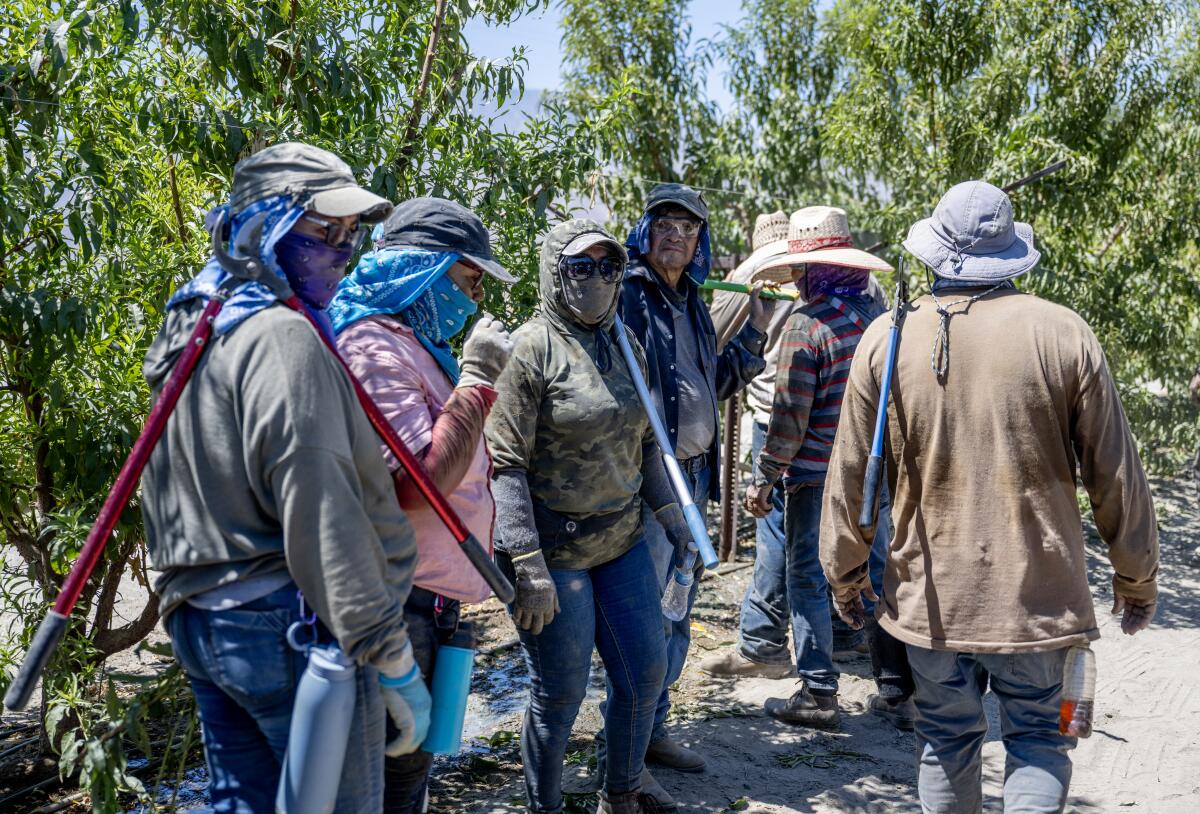Boiling Point: It’s not too late

- Share via
This story was originally published in Boiling Point, a newsletter about climate change and the environment. Sign up here to get it in your inbox.
It’s not too late to stop the climate crisis from getting worse.
But for California to lead the world toward a safer future, the state’s politicians, business leaders and tens of millions of residents will need to work a lot harder — and be willing to accept a tomorrow that looks different than today.
That’s what I write in a new story for The Times this week, focused on what Golden State residents — and, really, all Americans — can do in their own lives to fight global warming. My main conclusion: No matter how hard people work to limit their own heat-trapping emissions, there’s no more effective action they can take than to put pressure on elected officials.
But if you’ve got the time and money to work on reducing your environmental footprint? Then that can absolutely help.
And if you’re looking for advice, we’ve got it.
My story is part of a climate change special edition being published this month by The Times, focused on steps we can take to confront climate change. It will run in print on Aug. 27, but several of the pieces are online now. Here’s a quick rundown:
- My colleague Russ Mitchell has a fabulous guide to buying or leasing an electric car, including advice on price, driving range, models and access to charging. He also wrote about hydrogen fuel cell cars, noting that they currently “only work for those willing to suffer inconvenience for the satisfaction of living at the cutting edge of motor vehicle technology.”
- Looking to get by without a car in Los Angeles? It’s not easy in a city built around motor vehicles, but some people are doing it — either by choice or by economic necessity. Rachel Uranga talked with car-less Angelenos about their experiences.
- Susanne Rust tracked her plastic consumption for a week and shared the results with the world. Her piece was horrifying (by no fault of her own) and wildly illuminating, especially given the huge amounts of fossil fuel used to produce plastic. “We live in a world where convenience is expected, and the consequences of that lifestyle are largely hidden from us,” she wrote.
- Worried you’re recycling wrong? The Times’ Karen Garcia has a great breakdown of what goes in which bin and how to deal with food waste on plastic, plus useful advice on ways to reuse and donate clothes, books, furniture and more.
- Extreme heat, drought and fires are devastating Joshua trees — and even this winter’s rains didn’t help much, columnist Steve Lopez learned on a trip to the desert. The tree’s decline has had cascading consequences for wildlife, too.
- Should every Angeleno tear out their lawn? Or are there equally valuable ways to save water? David Wharton took a look.
- If you want to breathe clean air in Los Angeles, where should you live? The short answer is, there’s no perfect air anywhere — especially near Van Nuys Airport, where small planes are still allowed to use fuel containing brain-damaging lead. But you can limit your exposure with some legwork. Air quality reporter Tony Briscoe explains how he decied where to live.
One more thing — the L.A. Times is hosting an “Ask a Reporter” virtual event next month, focused on the climate change special edition. It’s scheduled for 6 p.m. on Tuesday, Sept. 19, and will feature environment reporter Rosanna Xia and me, in conversation with editor Maria La Ganga. We’ll take audience questions about our work and discuss Rosanna’s excellent new book, “California Against the Sea: Visions for Our Vanishing Coastline,” which publishes Sept. 26. You can get a free ticket here.
On that note, here’s what’s happening around the West:
Hawaii on fire

Although climate change alone is not to blame for the Maui fires — now the deadliest U.S. blaze in the last century, with over 100 people dead — fossil fuel pollution has primed Hawaii and other states for exactly this kind of devastation. For a breakdown of the role played by global warming in the Maui fires, see this sobering story by my colleagues Susanne Rust, Hayley Smith and Dorany Pineda. And while we don’t yet know exactly what ignited the flames, there’s early evidence that electric power lines may be to blame. The utility company Hawaiian Electric is already facing criticism for choosing not to shut off power during intense winds, especially given the aging, fire-prone state of its grid, the Washington Post’s Brianna Sacks reports.
“Nowhere is safe from the impact of warmer oceans and a rising global temperature, which can turn an idyllic town into a maelstrom of fire in a matter of hours. Not even Hawaii.” So writes L.A. Times columnist Mary McNamara, in a powerful call to action on the climate crisis. Columnist Anita Chabria focused on the need to adapt to our fast-changing world, writing, “We can no longer pretend that ingenuity and perseverance will overcome the perils of our warming planet.” And if this all sounds familiar to California readers, it may be because our state has been suffering similar climate consequences. My colleagues Rong-Gong Lin II, Jack Dolan and Robert Gauthier explored the similarities between the Maui fires and California’s recent deadly blazes.
Meanwhile, it just so happens that earlier this month, a youth-led climate lawsuit in Hawaii was scheduled for trial. Details here from Grist’s Anita Hofschneider, who writes that 14 young people are suing state officials for their role in promoting planet-warming pollution by prioritizing highway projects and other infrastructure that locks in long-term carbon emissions. Here on the mainland, in Montana, young people bringing a similar lawsuit against state government won an early courtroom victory this week, the Guardian’s Dharna Noor reports. These lawsuits and many others played out in recent weeks against the backdrop of what scientists have now confirmed was the hottest July on record — at least until next year, The Times’ Hayley Smith writes.
Around the West

For farmworkers living in mobile home parks in California’s Coachella Valley, extreme heat fueled by climate change is adding to the stress of unreliable air conditioning at home and dangerous working conditions in the fields. My colleague Paloma Esquivel spent time with some of those farmworkers and their families, chronicling the risks and indignities they face every single day. Elsewhere in the Golden State, some families that could afford to move choose to continue living in disaster-prone spots — and research suggests many of them probably won’t move even as the climate crisis brings worsening fires, storms and heat, Jack Flemming writes. And of course, it’s not just people at risk — Joshua trees, giant sequoias, bristlecone pines and other beloved California trees are succumbing to the consequences of global warming, Hayley Smith reports.
New research has concluded that the states of the Colorado River Basin face water stress similar to Saudi Arabia and Qatar — a troubling sign for California and neighboring states even after a wet winter. Here’s the story from my colleague Ian James. In other Colorado River news, the basin’s largest water user — the Imperial Irrigation District, which serves hundreds of farmers in California’s southeastern corner — hired its former arch-nemesis Jeffrey Kightlinger, who previously worked for Los Angeles and other major coastal cities, as a consultant. The Desert Sun’s Janet Wilson caught up with Kightlinger, who had some colorful comments comparing his former employer with the Dodgers and his new one with the San Diego Padres. Imperial also hired longtime energy department staffer Jamie Asbury as its new general manager.
Native American tribes and environmental justice groups say California is continuing a legacy of racist water law by not doing more to protect the Sacramento-San Joaquin River Delta. Now federal officials are investigating those claims, Ian James reports, in a case with the potential to force significant change to the state’s water distribution systems. James also wrote about environmentalists, tribal activists and fishing groups that hope a court ruling will lead Interior Secretary Deb Haaland to rescind a Trump-era, farmer-friendly water contract in the Central Valley. Gov. Gavin Newsom, meanwhile, signed an executive order to streamline levee repairs and debris removal from streams and flood-control channels ahead of another potentially wet winter. But critics are unhappy with Newsom for suspending environmental rules to make it happen, James reports.
Political climate

President Biden protected more than 900,000 acres around the Grand Canyon from new uranium mining, creating Baaj Nwaavjo I’tah Kukveni-Ancestral Footprints of the Grand Canyon National Monument. Tribes had asked the president for 1.1 million acres, but they were still thrilled by his decision, the Arizona Republic’s Brandon Loomis reports. Biden announced the monument at Red Butte, a sacred site for the Havasu ‘Baaja, the Republic’s Debra Utacia Krol writes. In another victory for tribes, a judge rejected Utah’s attempt to overturn Biden’s expansion of Bears Ears and Grand Staircase-Escalante national monuments, per the Salt Lake Tribune’s Jeff Parrott and Jacob Scholl. But Utah’s lawsuit is likely headed for the Supreme Court.
Sen. Dianne Feinstein (D-Calif.) couldn’t be at this year’s Lake Tahoe Summit, which she started in 1997 with then-Sen. Harry Reid (D-Nev.) as they worked to protect the beloved lake. But Sens. Alex Padilla (D-Calif.) and Catherine Cortez Masto (D-Nev.) honored Feinstein’s work to Keep Tahoe Blue — and called attention to the work that’s still needed, The Times’ Benjamin Oreskes writes. A couple of hundred miles south of Tahoe, California’s Owens Valley made it through the summer without terrible floods, which was feared following a wet winter. And in another positive outcome, the need to prepare for flooding led to close collaboration between Inyo County and its historic foes at the L.A. Department of Water and Power, Louis Sahagún reports.
For the second time, a single lawmaker — whose campaign was funded in part by labor unions and oil and gas companies — blocked a bill that would have required California pension funds to divest $14.8 billion from fossil fuel companies. Here’s the story from Aaron Cantú at Capital & Main, all about Assemblymember Tina McKinnor (D-Inglewood), who chairs the Committee on Public Employment and Retirement. Cantú also wrote a story highlighting that since 2019, California has sent $73 million to banks that finance fossil fuel companies — paying those banks, ironically, to help the state sell climate resiliency bonds to investors.
The energy transition
The Inflation Reduction Act signed by President Biden last year was designed to bring solar manufacturing back to the U.S. — and it seems to be working. One company just announced a record-sized solar factory for New Mexico, Canary Media’s Eric Wesoff writes, planning to invest more than $1 billion in an Albuquerque facility. Another solar firm just opened its first U.S. manufacturing plant in Las Vegas, and it says the Inflation Reduction Act is why, Sean Hemmersmeier reports for the Las Vegas Review-Journal. But as I’ve reported previously, we’ll need lots of new electric lines to carry solar power from the places where it’s generated to the places where it’s needed. That’s why the Biden administration has a new proposal to try to speed up permitting of transmission lines across federal land. Details here from Miranda Willson at E&E News.
New research links fine particulate matter and nitrogen dioxide — generated by gas-fired power plants and cars, among other sources — with prostate, colorectal, breast and endometrial cancers. This latest study — explained here by the Boston Herald’s Rick Sobey — is only the latest evidence that phasing out fossil fuels would have huge health benefits beyond limiting temperature increases. Those wide-ranging harms help explain why climate activists celebrated the news that for the first time, a gas utility company has ended its membership in the American Gas Assn. over the trade group’s stance on climate policy. Here’s the story from WBUR’s Miriam Wasser. Climate journalist Emily Atkin followed up on that news in her Heated newsletter, asking several other gas utilities — including Pacific Gas & Electric — why they’re still members of the industry trade group.
In last Thursday’s Boiling Point newsletter, I wrote about why the Edison Electric Institute — a trade group for electric utilities — had chosen to oppose President Biden’s latest clean energy plan. After that newsletter sent, several big electric companies who are members of the trade group — including PG&E and NextEra — put out their own comments on Biden’s plan, Bloomberg’s Jennifer A. Dlouhy reports, making clear they disagree with the stance taken by the Edison Electric Institute and its board chair, Pedro Pizarro. And in one last bit of Edison Electric Institute news, the group announced Wednesday that it had hired President Trump’s former Energy secretary Dan Brouillette as its new president and chief executive. Brouillette is currently an executive at a subsidiary of Southern California Gas parent company Sempra Energy, where he works on liquefied natural gas exports.
One more thing

This weekend I went to see “Oppenheimer,” Christopher Nolan’s film about America’s efforts to build the first atomic bomb.
There’s a big difference between nuclear weapons and nuclear energy, but the two share an intertwined history. Just see this recent story by the San Diego Union-Tribune’s Rob Nikolewski, about a small step forward for nuclear fusion energy technology at Lawrence Livermore National Laboratory — a federally funded research lab whose co-founders feature in Nolan’s film.
I’ve read plenty of valid criticism of “Oppenheimer,” including this piece by Cat Cardenas for The Times’ De Los project about the decades of radiation and cancer suffered by Hispano and Indigenous “downwinders” in New Mexico, where scientist Robert Oppenheimer and his colleagues tested the first atomic bomb — and the failure of “Oppenheimer” to address that legacy.
Emily Zemler, meanwhile, wrote about the film’s failure to explore the victims of America dropping nuclear weapons on Japan. “I was uncomfy watching yet another movie about tortured white male genius when the victims of the atrocities glossed over by the script — Japanese people, interned Japanese Americans, and Native Americans — had no voice,” one reviewer wrote.
Times film critic Justin Chang offered a counterpoint, calling it “an act of rigor, not erasure” that the film doesn’t show Hiroshima and Nagasaki. “Nolan trusts us to seek out and think about history for ourselves. If we elect not to, that’s on us,” Chang writes.
Personally, I found myself thinking about environmental activist Bill McKibben’s argument that the U.S. needs a World War II-style mobilization to combat the climate emergency. Nuclear weapons are horrifying. But I was spellbound as I watched the film to see the political and economic might that America’s leaders committed to developing atomic bombs in just a few years.
We treated winning World War II like an emergency. We should do the same for confronting climate change, because it is.
We’ll be back in your inbox Tuesday. To view this newsletter in your Web browser, click here. And for more climate and environment news, follow @Sammy_Roth on Twitter.
Toward a more sustainable California
Get Boiling Point, our newsletter exploring climate change, energy and the environment, and become part of the conversation — and the solution.
You may occasionally receive promotional content from the Los Angeles Times.






